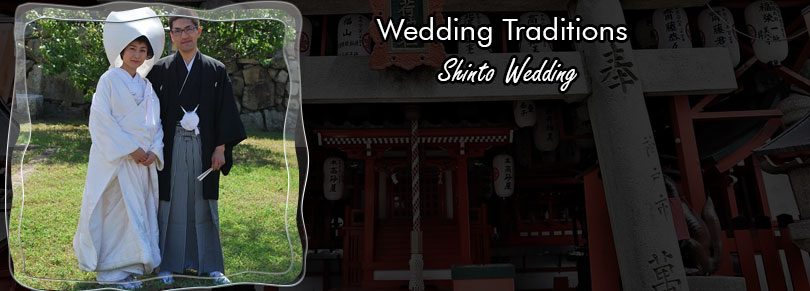Shinto or “Shin Tao” means “the way of the gods” and was established in Japan in 500 BC. The Shinto religion is characterised by nature worship, ancestor worship, heroism and divine expression.
The Shinto Bride
For the wedding ceremony, the bride is painted in white from head to toe symbolizing her maiden status to the gods. She wears a white kimono called the “Shiromuku” which is a Samurai tradition, where white symbolizes the beginning of a new life and the end of her old one. Its purity represents the bride’s willingness to be dyed in any colour conforming to her new family’s ways. The bridal gowns are considered very precious and are generally handed down through the generations and made into bedding.
The bride is covered in an elaborate head dress which is supposed to be her “horns of jealousy and envy” towards her mother-in-law who is the head of the family. In contrast, the groom wears a simple black kimono.
The Wedding Ceremony
The wedding ceremony begins with the priest purifying all those present in order to keep away the evil spirits. The bride and groom offer vows of obedience and faithfulness to one another in front of the gathered relatives. Then the “San-San- Kudo” ceremony follows where the couple passes a nuptial cup containing sake (rice wine) between them as many as nine times. It is believed that when they pass this cup between them it helps to seal their bond.
It is then offered to the family and guests present thus celebrating the union. While the bride and the groom exchange their wedding vows, their families face each other, instead of facing the couple. After the “San-San-Kudo” ceremony, the bride and the groom exchange rings. The ceremony concludes in the sanctuary where the couple offer twigs to Sakaki or sacred tree in worship to Kami (Shinto God).
Wedding Reception
The bride will change her kimono many times during the reception but she usually begins the celebration in a red kimono. The colours red and white are considered auspicious in a Japanese wedding and sometimes this colour scheme extends into the food at the reception. The wedding party and invited guests engage in games, skits and karaoke during the wedding reception. In Japan certain dates are considered lucky and it is not uncommon to see railway stations full of newly weds heading for their honeymoon on these days!!!!
Mary Samuel is a B.E , MBA and has worked in VSSC,ISRO (Trivandrum) and H&R Johnson (I) Ltd. She is at present a homemaker, married to Maj L. J. John and blessed with two sons, Daniel & David.






Leave a Comment